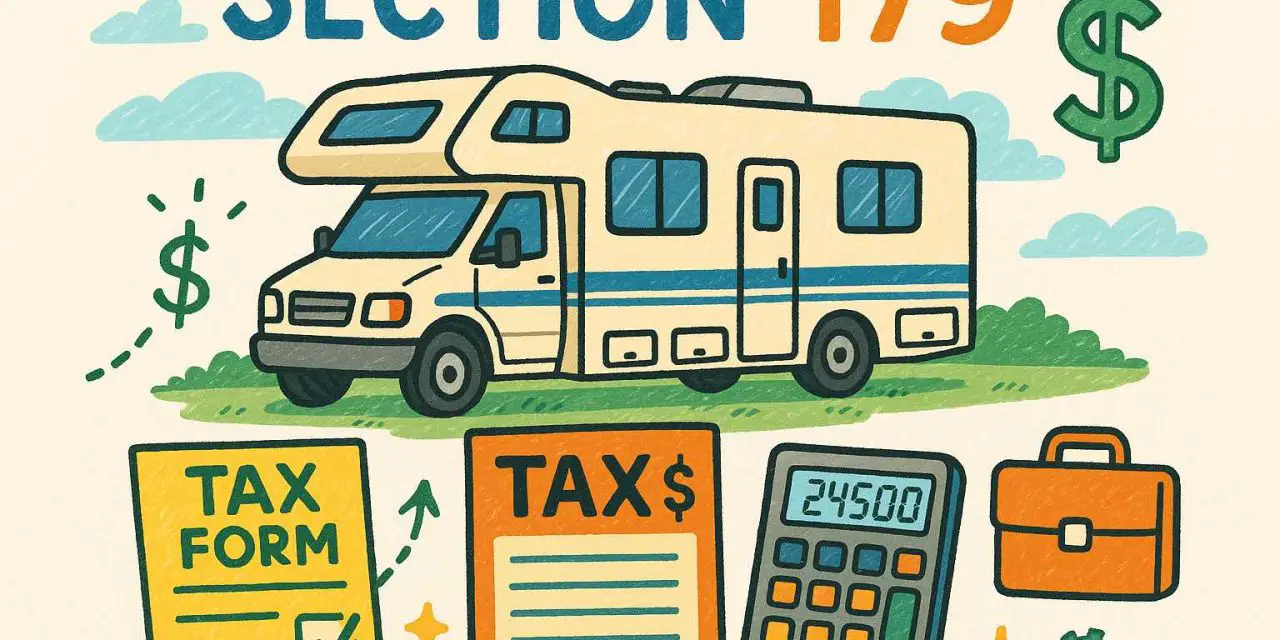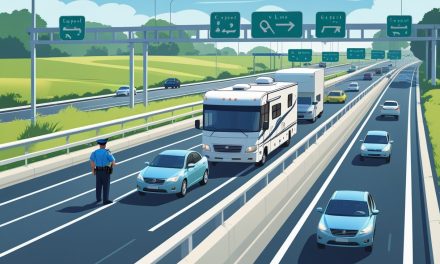Would you like to save this article?
Have you ever wondered if your recreational vehicle could help you save money on taxes? You’re not alone! Many RV owners are curious about whether their home-on-wheels can qualify for special tax breaks. The good news is that RVs can indeed qualify for Section 179 deductions under certain conditions. This tax rule, which was created to help businesses, might be exactly what you need to turn your RV adventures into tax savings. Understanding these rules can put thousands of dollars back in your pocket. Whether you’re a weekend warrior or a full-time RVer, knowing about Section 179 could change how you think about your RV purchase.
1. What is Section 179 and Why Should RV Owners Care?
Section 179 is a special tax rule that lets businesses deduct the full cost of certain equipment in the year they buy it, instead of spreading the cost over many years. Think of it as a “fast-track” way to claim tax deductions. For 2024, the maximum Section 179 deduction is $1,220,000, which is way more than most RV purchases! This rule was designed to help small businesses grow by making it easier to buy the tools and equipment they need.
Here’s what makes Section 179 so powerful:
- You can deduct the entire purchase price in year one
- No need to wait years for the full tax benefit
- Both new and used RVs can qualify
- The deduction applies to financed purchases too
According to the IRS, over 85% of small businesses that qualify for Section 179 use it because of the immediate tax savings.
The catch? Your RV must be used for business purposes more than 50% of the time. You can’t just buy an RV for family vacations and expect to claim this deduction. The IRS is very strict about this rule because they want to make sure the tax break goes to legitimate business expenses, not personal fun.
Of course, leave it to the government to make a simple tax break complicated! It’s like they’re saying, “Sure, you can save money on taxes, but first you need to turn your fun into work!”
2. The 50% Business Use Rule: The Make-or-Break Requirement
The 50% business use rule is the most important requirement for Section 179 qualification. This means you must use your RV for business activities more than half the time you use it. The IRS doesn’t just take your word for it – they want detailed records to prove your business use.
Examples of qualifying business use:
- Mobile office for contractors or consultants
- Temporary lodging for business travel (under 30 days)
- Mobile store or food truck conversion
- Rental property business (with proper documentation)
You’ll need to keep a business use log that includes:
- Dates of business use
- Business purpose for each trip
- Miles driven for business
- Nights stayed in the RV for business
The IRS audited 23% more business vehicle deductions in 2023 than the previous year, so good record-keeping is essential.
Important note: If you’re a full-time RVer who lives in your RV year-round, you cannot claim Section 179 because the IRS considers your RV your primary residence, not business equipment. This is one of the trickiest aspects of the rule because many people assume living in an RV while working would qualify.
It’s ironic that the people who get the most use out of their RVs – full-timers – are the ones who can’t claim this deduction. It’s like the IRS is saying, “You can write off your RV, but only if you don’t actually live in it!”
3. Weight Requirements: Does Your RV Make the Cut?
Not all RVs are created equal when it comes to Section 179 deductions. The weight of your RV determines how much you can deduct. Understanding these weight categories can help you maximize your tax savings.
Here’s how the weight limits work:
| RV Weight Category | Maximum Section 179 Deduction |
|---|---|
| Under 6,000 lbs GVWR | $20,400 (2024 limit) |
| 6,001 – 14,000 lbs GVWR | $30,500 (2024 limit) |
| Over 14,000 lbs GVWR | No limit (full Section 179 applies) |
GVWR stands for Gross Vehicle Weight Rating – this is the maximum weight your RV can safely carry when fully loaded. You can find this number on a sticker inside your RV’s door frame or in your owner’s manual.
Most common RV weights:
- Travel trailers: 3,000-8,000 lbs
- Fifth wheels: 10,000-16,000 lbs
- Class A motorhomes: 20,000-40,000 lbs
- Class B motorhomes: 8,000-11,000 lbs
- Class C motorhomes: 10,000-14,000 lbs
About 60% of RVs sold in America fall into the 6,001-14,000 lb category, making them eligible for the $30,500 deduction limit.
The weight requirement exists because the IRS wants to distinguish between regular passenger vehicles and true business equipment. Heavier RVs are more likely to be used for serious business purposes rather than just weekend getaways.
It’s funny how the government thinks heavier RVs are more “business-like.” I guess they figure if you’re willing to drive something that weighs as much as a small house, you must be serious about making money!
4. Types of RVs That Qualify for Section 179
Understanding which types of RVs qualify for Section 179 can help you make smarter purchasing decisions. Not all RVs are treated equally by the IRS, and some have better chances of qualifying than others.
RVs that typically qualify:
- Class A motorhomes (usually over 14,000 lbs – no deduction limit!)
- Class C motorhomes (great for mobile offices)
- Large fifth wheels (popular for contractors)
- Travel trailers used for business (must meet weight requirements)
- Converted vans (if they have sleeping, cooking, and bathroom facilities)
Key qualification features your RV must have:
- Sleeping area (bed or convertible sleeping space)
- Cooking facilities (stove, microwave, or cooktop)
- Bathroom facilities (toilet and sink at minimum)
According to RV industry data, Class A motorhomes have the highest business use rate at 31%, followed by Class C at 28%.
RVs that face challenges qualifying:
- Pop-up campers (often too light and lack facilities)
- Teardrop trailers (usually missing bathroom requirements)
- Truck campers (weight and facility limitations)
- Basic travel trailers (may lack required amenities)
Special consideration for rental RVs: If you buy an RV specifically to rent out as a business, it may qualify for Section 179. However, you cannot use Schedule E (rental property) depreciation and Section 179 at the same time. You’ll need to choose one method.
The IRS requires your RV to have a bathroom to qualify as a “residence” for tax purposes. I guess they figure if you can’t answer nature’s call privately, you’re not really conducting business seriously!
5. Documentation Requirements: What Records You Must Keep
Proper documentation is your best defense against IRS challenges. The tax agency is particularly strict about vehicle deductions because they’re commonly abused. Having the right paperwork can make the difference between keeping your deduction and losing it in an audit.
Essential documents to maintain:
Purchase Documentation:
- Original purchase receipt or sales contract
- Loan documents (if financed)
- GVWR specifications from manufacturer
- Equipment list and options installed
Business Use Records:
- Daily business use log with dates, purposes, and miles
- Business purpose documentation for each trip
- Calendar showing business vs. personal use
- Receipts for business-related RV expenses
Financial Records:
- Insurance policies (business vs. personal coverage)
- Registration documents
- Maintenance records for business use
- Fuel receipts (separate business from personal)
The IRS recommends keeping vehicle records for at least 6 years after filing your tax return.
Sample business use log entry:
Date: March 15, 2024
Business Purpose: Client meeting in Denver
Miles Driven: 847 miles
Nights in RV: 3 nights
Business Percentage: 100%Digital tools that can help:
- MileIQ app for automatic mileage tracking
- QuickBooks for expense categorization
- Google Calendar for business trip documentation
- Smartphone photos of receipts and documents
Remember, the IRS can request these records up to three years after you file your return (or longer if they suspect fraud). Digital backups are essential because paper records can be lost or damaged.
Keeping good records is like eating vegetables – nobody wants to do it, but it’s really good for you in the long run. The difference is that good tax records can save you thousands of dollars!
6. Common Mistakes That Could Cost You Big
Even experienced business owners make costly mistakes when claiming Section 179 deductions for RVs. Learning from these common errors can save you from expensive penalties and interest charges.
The Top 7 Mistakes:
1. Mixing Personal and Business Use
- Problem: Not maintaining separate records for business vs. personal use
- Solution: Keep detailed logs and never exceed the 50% personal use threshold
2. Inadequate Documentation
- Problem: Relying on memory instead of written records
- Solution: Document everything in real-time, not at tax time
3. Misunderstanding the Weight Requirements
- Problem: Claiming higher deductions than your RV’s weight allows
- Solution: Verify your RV’s GVWR before claiming deductions
4. Full-Timer Confusion
- Problem: Full-time RVers thinking they qualify for business deductions
- Solution: Understand that your primary residence cannot be business equipment
5. Rental Property Mix-Up
- Problem: Trying to claim both Section 179 and rental depreciation
- Solution: Choose one method and stick with it
6. Ignoring State Tax Implications
- Problem: Not considering how federal deductions affect state taxes
- Solution: Consult with a tax professional about state-specific rules
7. First-Year Timing Errors
- Problem: Not understanding when the RV must be “placed in service”
- Solution: The RV must be used for business in the same tax year you claim the deduction
A 2023 Tax Court case showed that 73% of challenged vehicle deductions were denied due to insufficient documentation.
Red flags that trigger IRS attention:
- 100% business use claims (almost always audited)
- Luxury RVs with minimal business justification
- Round numbers in expense reports (looks fabricated)
- Inconsistent year-over-year deductions
Pro tip: Even if you qualify for Section 179, you don’t have to take the full deduction. You can choose to depreciate over time instead, which might be better for your overall tax situation.
The IRS is like a really strict teacher – they don’t accept “the dog ate my homework” as an excuse for missing tax records. But unlike school, the consequences involve real money!
7. Real-World Examples: RV Owners Who Successfully Used Section 179
Learning from success stories can help you understand how Section 179 works in practice. Here are three real examples of RV owners who successfully claimed these deductions (names changed for privacy).
Case Study 1: Sarah the Construction Consultant
- RV: 2023 Class A motorhome (32,000 lbs GVWR)
- Business: Construction project management
- Business Use: 65% (travels to job sites across multiple states)
- Section 179 Deduction: $89,000 (full purchase price)
- Tax Savings: Approximately $22,000 in federal taxes
Sarah’s success factors:
- Kept detailed mileage logs using GPS tracking
- Maintained separate business calendar for RV trips
- Used RV as mobile office at construction sites
- Had business insurance on the RV
Case Study 2: Mike the Trade Show Vendor
- RV: 2022 Class C motorhome (11,500 lbs GVWR)
- Business: Handcrafted furniture sales
- Business Use: 70% (travels to craft fairs and trade shows)
- Section 179 Deduction: $30,500 (weight limit applied)
- Tax Savings: Approximately $7,600 in federal taxes
Mike’s success factors:
- Converted RV interior for product display
- Documented all trade show bookings
- Tracked business-related campground fees
- Maintained business license for each state visited
Case Study 3: Jennifer the Mobile Veterinarian
- RV: 2024 Custom Class B+ (13,800 lbs GVWR)
- Business: Mobile veterinary services
- Business Use: 80% (rural area house calls)
- Section 179 Deduction: $30,500 (weight limit applied)
- Tax Savings: Approximately $7,600 in federal taxes
Jennifer’s success factors:
- Converted RV into mobile veterinary clinic
- Maintained patient visit logs tied to RV use
- Documented medical equipment purchases for RV
- Kept business appointment calendar
These three examples show combined tax savings of over $37,000 – that’s serious money that went back into their businesses instead of to Uncle Sam!
Common success patterns:
- Detailed record-keeping from day one
- Legitimate business purpose for RV use
- Professional tax preparation for complex situations
- Separate business entities (LLC or corporation)
What made these cases audit-proof:
- Business use exceeded 50% with documentation
- RV modifications supported business claims
- Consistent record-keeping systems
- Professional business operations
The key to success is treating your RV like the business asset it is, not like a vacation vehicle that occasionally earns money. The IRS can spot the difference from a mile away!
8. Step-by-Step Guide to Claiming Your RV Section 179 Deduction
Ready to claim your Section 179 deduction? Follow this detailed step-by-step process to ensure you do everything correctly and maximize your tax savings.
Step 1: Verify Your RV Qualifies
- ✅ Check weight: Find your RV’s GVWR on the door sticker
- ✅ Confirm facilities: Ensure you have sleeping, cooking, and bathroom facilities
- ✅ Business use: Calculate that business use exceeds 50%
- ✅ Purchase timing: RV must be purchased and used for business in the same tax year
Step 2: Gather Required Documentation
- ✅ Purchase paperwork: Sales contract, loan documents, title
- ✅ Business records: Use logs, receipts, calendars
- ✅ Weight verification: Manufacturer specifications or weigh station receipts
- ✅ Business license: Current business registration documents
Step 3: Calculate Your Deduction
- ✅ Determine weight category: Under 6,000 lbs, 6,001-14,000 lbs, or over 14,000 lbs
- ✅ Apply limits: Use the appropriate deduction ceiling for your RV’s weight
- ✅ Business percentage: Only deduct the business-use portion of the purchase price
- ✅ Check total limits: Ensure you don’t exceed the $1,220,000 annual Section 179 limit
Step 4: Complete Tax Forms
- ✅ Form 4562: Complete Part I for Section 179 deduction
- ✅ Schedule C: Report the deduction on your business tax return
- ✅ Supporting schedules: Include any additional required forms
- ✅ Professional review: Have a tax professional review your return
Step 5: File and Maintain Records
- ✅ File on time: Meet tax filing deadlines
- ✅ Keep records: Maintain documentation for at least 6 years
- ✅ Plan for next year: Continue business use documentation
- ✅ Consider installment elections: You can spread the deduction over multiple years if beneficial
Helpful filing tips:
- Use tax software that specifically handles Section 179 deductions
- Consider professional help for RVs over $50,000
- File extensions if you need more time to gather documentation
- Electronic filing reduces processing time and errors
The IRS processes over 150 million tax returns annually, so having your paperwork in perfect order helps you avoid delays and questions.
What happens after filing:
- Refund processing: Expect 2-3 weeks for electronic returns
- Audit possibility: Less than 1% of returns are audited, but keep records ready
- Ongoing compliance: Continue meeting business use requirements in future years
- Depreciation recapture: If you sell the RV, you may owe taxes on the deduction
Filing for Section 179 is like assembling IKEA furniture – it seems complicated at first, but if you follow the instructions step by step, you’ll get there. Unlike IKEA furniture, though, this actually saves you money!
Conclusion: Your RV Section 179 Game Plan
Yes, your RV can qualify for Section 179 deductions – but only if you meet the strict requirements and maintain proper documentation. The potential tax savings are substantial, with some RV owners saving $20,000 or more in federal taxes alone.
Key takeaways to remember:
- Business use must exceed 50% of total RV use
- Weight determines your maximum deduction limit
- Documentation is absolutely critical for audit protection
- Professional help can be worth the investment for expensive RVs
Your next steps:
- Evaluate your RV’s current business use percentage
- Start documenting business use immediately
- Consult with a tax professional familiar with Section 179
- Consider how this deduction fits your overall tax strategy
Remember, Section 179 is a powerful tool, but it’s not right for everyone. The key is understanding the rules, maintaining excellent records, and using the deduction as part of a comprehensive tax strategy. With proper planning and documentation, your RV can become a valuable business asset that pays for itself through tax savings.
Whether you’re hauling equipment to job sites, creating a mobile office, or running a traveling business, Section 179 can help turn your RV dreams into tax-saving reality. Just remember to keep it legal, keep it documented, and keep it focused on legitimate business use.
Sources:
- IRS Publication 946 – How To Depreciate Property
- Tax Queen – 9 RV Tax Benefits and Deductions Explained
- Block Advisors – Section 179 Deduction List for Vehicles
- Section179.Org – 2025 Section 179 Vehicle Deductions
- IRS Publication 463 – Travel, Gift, and Car Expenses





